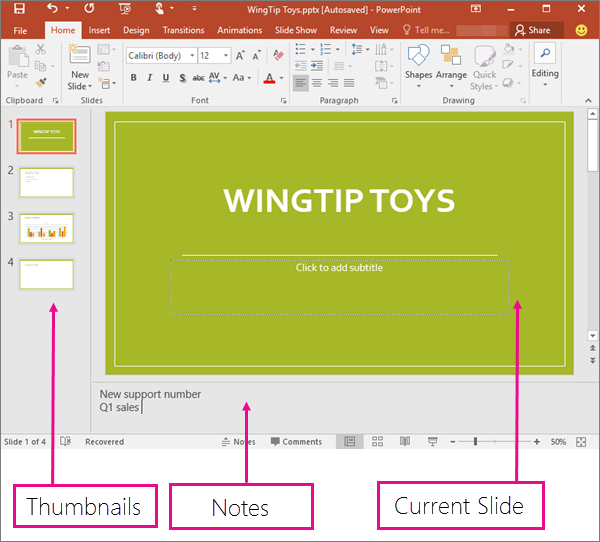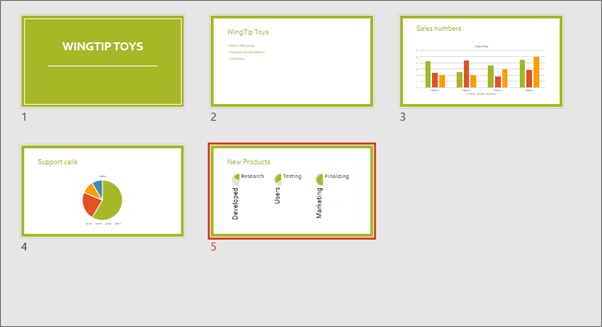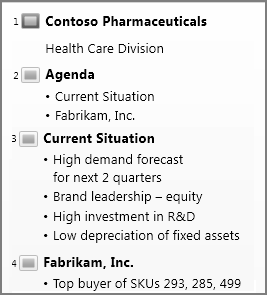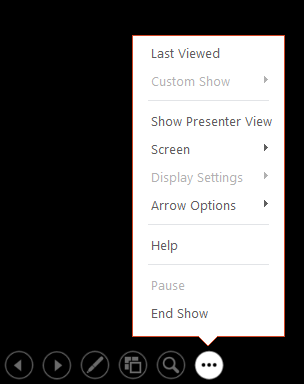Choose the right view for the task in PowerPoint
You can view your PowerPoint slides in a variety of ways depending on the task at hand. Some views are helpful when you're creating your presentation, and some are most helpful for delivering your presentation.
You can find the different PowerPoint view options on the View tab, as shown below.

You can also find the most frequently used views on the task bar at the bottom right of the slide window, as shown below.

Views for creating your presentation
Normal view
You can get to Normal view from the task bar  at the bottom of the slide window, or from the View tab on the ribbon.
at the bottom of the slide window, or from the View tab on the ribbon.
Normal view is where you'll work most frequently to create your slides. Below, Normal view displays slide thumbnails on the left, a large window showing the current slide, and a section below the current slide where you can type your speaker notes for that slide.

Slide Sorter view
You can get to Slide Sorter view from the task bar  at the bottom of the slide window, or from the View tab on the ribbon.
at the bottom of the slide window, or from the View tab on the ribbon.
Slide Sorter view (below) displays all the slides in your presentation in horizontally sequenced, thumbnails. Slide show view is helpful if you need to reorganize your slides – you can just click and drag your slides to a new location, or add sections to organize your slides into meaningful groups.

For more information about sections, see Use sections to organize your slides into groups.
Notes Page view
You can show or hide your speakers notes with the Notes button  at the bottom of the slide window, or you can get to Notes Page view from the View tab on the ribbon.
at the bottom of the slide window, or you can get to Notes Page view from the View tab on the ribbon.
The Notes pane is located beneath the slide window. You can print your notes or include the notes in a presentation that you send to the audience, or just use them as cues for yourself while you're presenting.

For more information about notes, see Add speaker notes to your slides.
Outline view
You can get to Outline view from the View tab on the ribbon.
Note: In PowerPoint 2013 and later, you can no longer get to Outline view from Normal view. You'll need to get to it from the View tab.
Use Outline view to create an outline or story board for your presentation. It displays only the text on your slides.

Master views
To get to a master view, on the View tab, in the Master Views group, choose the master view that you want.
Master views include, Slide, Handout, and Notes. The key benefit to working in a master view is that you can make universal style changes to every slide, notes page, or handout associated with your presentation.
For more information about working with masters, see:
Views for delivering and viewing a presentation
Slide Show view
You can get to SlideShow view from the task bar  at the bottom of the slide window..
at the bottom of the slide window..
Use Slide Show view to deliver your presentation to your audience. Slide Show view occupies the full computer screen, exactly the way your presentation will look on a big screen when your audience sees it.
Presenter view
To get to Presenter view, in Slide Show view, in the lower left corner of the screen, click  , and then click Show Presenter View (as shown below).
, and then click Show Presenter View (as shown below).
Use Presenter view to view your notes while delivering your presentation. In Presenter view, your audience cannot see your notes.

For more information about using Presenter view, see View your speaker notes as you deliver your slide show.
Reading view
You can get to Reading view from the task bar  at the bottom of the slide window..
at the bottom of the slide window..
Most people reviewing a PowerPoint presentation without a presenter will want to use Reading view. It displays the presentation in a full screen like Slide Show view, and it includes a few simple controls to make it easy to flip through the slides.
No comments:
Post a Comment